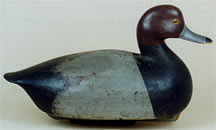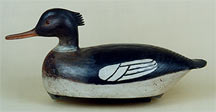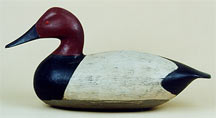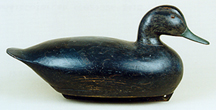by James L. Trimble
Located in southeast Sussex County, two miles west of the Atlantic Ocean, sits the small rural town of Ocean View, Delaware. Established in 1688 and incorporated in 1889, Ocean View was originally a 500-acre tract granted by Lord Baltimore. The town’s name was established, according to local legend, when a sea captain claimed he could see the Atlantic Ocean from his second story bedroom window.
Ocean View is situated on White’s Creek, a shallow tributary that feeds north to Indian River and Rehoboth Bay, and connects south to the Little and Big Assawoman Bays. At the beginning of the 20th century many of the town’s citizens worked on the water or in the newly established broiler chicken industry that began there and spread throughout the Delmarva Peninsula. Ocean View is also the birthplace of Edson Gray, Delaware’s best-known and finest maker of hunting decoys.
Born in 1891 Gray grew up along Cedar Creek, just outside of Ocean View, hunting the tidal bays and marshes that surrounded the area. His unusual family name was pronounced "Edison" locally, and he carried that moniker for his entire life.
 Many of Gray’s decoys are uniquely constructed using a variety of materials and reflecting many different styles. His early cork decoys are reminiscent of those made on Long Island, with the exception of the tail treatment. It’s quite possible that Gray was influenced while living in New Jersey where he may have hunted over Long Island decoys or simply came in contact with them. These cork decoys have a finely carved tail section made from pine, representing about 20% of the overall body length, for added durability. It was doweled to the cork body and pine bottom board. The finely carved pine heads are attached with a dowel that runs through the cork body and inserts into the pine keel. His large oversized balsa ducks and geese, designed for large open bodies of water, had an added pine or cedar tail for additional strength as well. The cover of "Decoys of the Mid-Atlantic Region" by Henry Fleckenstein showcases an example of his balsa geese. But Gray mixed materials for texture as well. The upper layer of many of his round-bodied pine decoys is made of cork. The cork adds texture to the feather patterns and absorbs any light reflection from the paint. Many of Gray’s decoys are uniquely constructed using a variety of materials and reflecting many different styles. His early cork decoys are reminiscent of those made on Long Island, with the exception of the tail treatment. It’s quite possible that Gray was influenced while living in New Jersey where he may have hunted over Long Island decoys or simply came in contact with them. These cork decoys have a finely carved tail section made from pine, representing about 20% of the overall body length, for added durability. It was doweled to the cork body and pine bottom board. The finely carved pine heads are attached with a dowel that runs through the cork body and inserts into the pine keel. His large oversized balsa ducks and geese, designed for large open bodies of water, had an added pine or cedar tail for additional strength as well. The cover of "Decoys of the Mid-Atlantic Region" by Henry Fleckenstein showcases an example of his balsa geese. But Gray mixed materials for texture as well. The upper layer of many of his round-bodied pine decoys is made of cork. The cork adds texture to the feather patterns and absorbs any light reflection from the paint.
 Gray primarily carved diving ducks, black ducks, mergansers and Canada geese. Some have mandible carving on the bills, but mergansers are the only species that shows separation between the upper and lower bill. The tail position also varied – some slightly swept up, some slightly swept down and others were straight back, even within the same rig. Adding to the mixed bag, some have fluted tails. Most of Gray’s decoys were made of solid cedar, although a few hollow examples are known. Gray primarily carved diving ducks, black ducks, mergansers and Canada geese. Some have mandible carving on the bills, but mergansers are the only species that shows separation between the upper and lower bill. The tail position also varied – some slightly swept up, some slightly swept down and others were straight back, even within the same rig. Adding to the mixed bag, some have fluted tails. Most of Gray’s decoys were made of solid cedar, although a few hollow examples are known.
 Gray’s canvasbacks and black ducks are found in the widest variety of styles. They include both round and flat-bottomed birds, some with carved raised primaries that are reminiscent of Delaware River decoys. Apparently Gray’s artistic inclinations interfered with the routine of producing the same decoy over and over again. But it was Gray’s rounded semi-butterball bluebills, with their fine mandible and bill carving, which Patterson referred to in describing his work as "decoy sculpture at its best." Gray’s canvasbacks and black ducks are found in the widest variety of styles. They include both round and flat-bottomed birds, some with carved raised primaries that are reminiscent of Delaware River decoys. Apparently Gray’s artistic inclinations interfered with the routine of producing the same decoy over and over again. But it was Gray’s rounded semi-butterball bluebills, with their fine mandible and bill carving, which Patterson referred to in describing his work as "decoy sculpture at its best."
 The paint patterns were well executed in a basic mid-Atlantic style and all have glass eyes. On his canvasback decoys it appears that Gray used ruby red oblong hatpins, inset sideways, with a black dot painted for a pupil, almost giving the eyes a protruding focused look. Many decoys, except for the black ducks, have an additional coat of gray paint applied to the bottom. In rough water, this would eliminate light reflection in case the stool overturned. Gray repaired and repainted his rig as needed; his bill repairs are easily recognizable by their tight mortised connection. The paint patterns were well executed in a basic mid-Atlantic style and all have glass eyes. On his canvasback decoys it appears that Gray used ruby red oblong hatpins, inset sideways, with a black dot painted for a pupil, almost giving the eyes a protruding focused look. Many decoys, except for the black ducks, have an additional coat of gray paint applied to the bottom. In rough water, this would eliminate light reflection in case the stool overturned. Gray repaired and repainted his rig as needed; his bill repairs are easily recognizable by their tight mortised connection.
 When Edson Gray died in 1982, Delaware lost its finest decoy maker. But many of his decoys remain in the homes of his Ocean View neighbors, quite possibly on fireplace mantles and in family room additions that he built while working as a carpenter. After family and friends made their selections, the remainder of his decoys was sold at a local auction, bringing about $65 a bird. That’s why those southeastern Sussex County estate auctions always catch my attention. You’ll never know when one of Gray’s fine decoy sculptures may just show up. When Edson Gray died in 1982, Delaware lost its finest decoy maker. But many of his decoys remain in the homes of his Ocean View neighbors, quite possibly on fireplace mantles and in family room additions that he built while working as a carpenter. After family and friends made their selections, the remainder of his decoys was sold at a local auction, bringing about $65 a bird. That’s why those southeastern Sussex County estate auctions always catch my attention. You’ll never know when one of Gray’s fine decoy sculptures may just show up.
For the complete story, please see the July/Aug. 2001 issue of Decoy Magazine.
Tidbits Main Index

|


